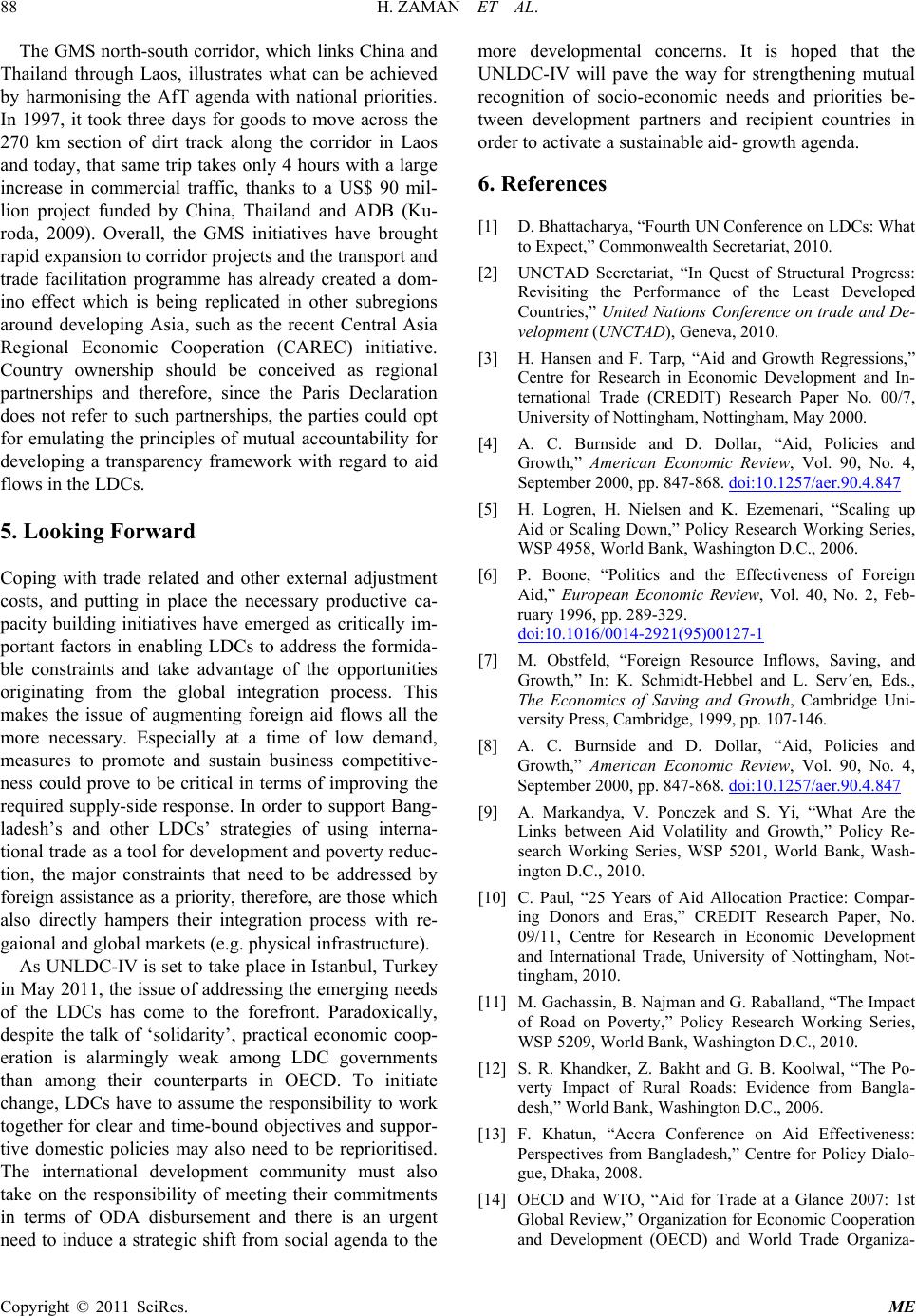
H. ZAMAN ET AL.
Copyright © 2011 SciRes. ME
The GMS north-south corridor, which links China and
Thailand through Laos, illustrates what can be achieved
by harmonising the AfT agenda with national priorities.
In 1997, it took three days for goods to move across the
270 km section of dirt track along the corridor in Laos
and today, that same trip takes only 4 hours with a large
increase in commercial traffic, thanks to a US$ 90 mil-
lion project funded by China, Thailand and ADB (Ku-
roda, 2009). Overall, the GMS initiatives have brought
rapid expansion to corridor projects and the transport and
trade facilitation programme has already created a dom-
ino effect which is being replicated in other subregions
around developing Asia, such as the recent Central Asia
Regional Economic Cooperation (CAREC) initiative.
Country ownership should be conceived as regional
partnerships and therefore, since the Paris Declaration
does not refer to such partnerships, the parties could opt
for emulating the principles of mutual accountability for
developing a transparency framework with regard to aid
flows in the LDCs.
5. Looking Forward
Coping with trade related and other external adjustment
costs, and putting in place the necessary productive ca-
pacity building initiatives have emerged as critically im-
portant factors in enabling LDCs to address the formida-
ble constraints and take advantage of the opportunities
originating from the global integration process. This
makes the issue of augmenting foreign aid flows all the
more necessary. Especially at a time of low demand,
measures to promote and sustain business competitive-
ness could prove to be critical in terms of improving the
required supply-side response. In order to support Bang-
ladesh’s and other LDCs’ strategies of using interna-
tional trade as a tool for development and poverty reduc-
tion, the major constraints that need to be addressed by
foreign assistance as a priority, therefore, are those which
also directly hampers their integration process with re-
gaional and global markets (e.g. physical infrastructure).
As UNLDC-IV is set to take place in Istanbul, Turkey
in May 2011, the issue of addressing the emerging needs
of the LDCs has come to the forefront. Paradoxically,
despite the talk of ‘solidarity’, practical economic coop-
eration is alarmingly weak among LDC governments
than among their counterparts in OECD. To initiate
change, LDCs have to assume the responsibility to work
together for clear and time-bound objectives and suppor-
tive domestic policies may also need to be reprioritised.
The international development community must also
take on the responsibility of meeting their commitments
in terms of ODA disbursement and there is an urgent
need to induce a strategic shift from social agenda to the
more developmental concerns. It is hoped that the
UNLDC-IV will pave the way for strengthening mutual
recognition of socio-economic needs and priorities be-
tween development partners and recipient countries in
order to activate a sustainable aid- growth agenda.
6. References
[1] D. Bhattacharya, “Fourth UN Conference on LDCs: What
to Expect,” Commonwealth Secretariat, 2010.
[2] UNCTAD Secretariat, “In Quest of Structural Progress:
Revisiting the Performance of the Least Developed
Countries,” United Nations Conference on trade and De-
velopment (UN CTAD), Geneva, 2010.
[3] H. Hansen and F. Tarp, “Aid and Growth Regressions,”
Centre for Research in Economic Development and In-
ternational Trade (CREDIT) Research Paper No. 00/7,
University of Nottingham, Nottingham, May 2000.
[4] A. C. Burnside and D. Dollar, “Aid, Policies and
Growth,” American Economic Review, Vol. 90, No. 4,
September 2000, pp. 847-868. doi:10.1257/aer.90.4.847
[5] H. Logren, H. Nielsen and K. Ezemenari, “Scaling up
Aid or Scaling Down,” Policy Research Working Series,
WSP 4958, World Bank, Washington D.C., 2006.
[6] P. Boone, “Politics and the Effectiveness of Foreign
Aid,” European Economic Review, Vol. 40, No. 2, Feb-
ruary 1996, pp. 289-329.
doi:10.1016/0014-2921(95)00127-1
[7] M. Obstfeld, “Foreign Resource Inflows, Saving, and
Growth,” In: K. Schmidt-Hebbel and L. Serv´en, Eds.,
The Economics of Saving and Growth, Cambridge Uni-
versity Press, Cambridge, 1999, pp. 107-146.
[8] A. C. Burnside and D. Dollar, “Aid, Policies and
Growth,” American Economic Review, Vol. 90, No. 4,
September 2000, pp. 847-868. doi:10.1257/aer.90.4.847
[9] A. Markandya, V. Ponczek and S. Yi, “What Are the
Links between Aid Volatility and Growth ,” Policy Re-
search Working Series, WSP 5201, World Bank, Wash-
ington D.C., 2010.
[10] C. Paul, “25 Years of Aid Allocation Practice: Compar-
ing Donors and Eras,” CREDIT Research Paper, No.
09/11, Centre for Research in Economic Development
and International Trade, University of Nottingham, Not-
tingham, 2010.
[11] M. Gachassin, B. Najman and G. Raballand, “The Impact
of Road on Poverty,” Policy Research Working Series,
WSP 5209, World Bank, Washington D.C., 2010.
[12] S. R. Khandker, Z. Bakht and G. B. Koolwal, “The Po-
verty Impact of Rural Roads: Evidence from Bangla-
desh,” World Bank, Washington D.C., 2006.
[13] F. Khatun, “Accra Conference on Aid Effectiveness:
Perspectives from Bangladesh,” Centre for Policy Dialo-
gue, Dhaka, 2008.
[14] OECD and WTO, “Aid for Trade at a Glance 2007: 1st
Global Review,” Organization for Economic Cooperation
and Development (OECD) and World Trade Organiza-